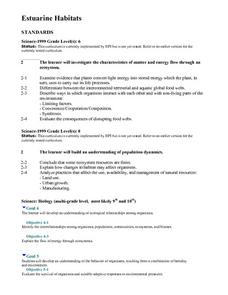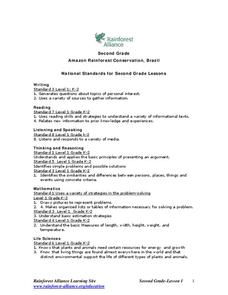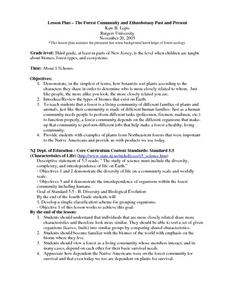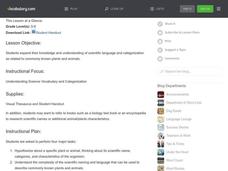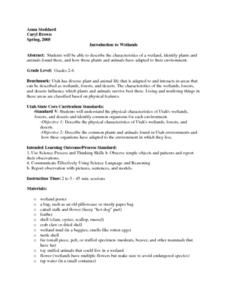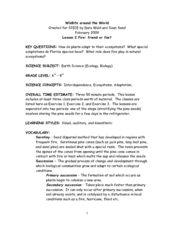Curated OER
The Plant and Animal Walk
Students draw pictures and write words to describe objects and experiences. They observe outside and draw at least three animals and three plants. Students observe plants and animals describing how they are alike and how they are...
Curated OER
Invasive Species
Students use the Internet to research non-native plants that exist in their local community. Using this information, they analyze the invasive species effect on their environment. In groups, they plan and execute their own project to...
Curated OER
Plant Parts with Sequencing Cube
Third graders listen to the story, Jack's Garden by Henry Cole. They learn the parts of the plant by looking at live plants.
Curated OER
Estuarine Habitats
Sixth graders study the important habitats, flora, fauna, and physical factors of coastal habitats. They compare the aquatic habitats to terrestrial habitats by researching and completing tables with the information.
Curated OER
Tagging Race
Students examine and identify plant parts to recognize specific weeds, identify three different weeds, discern differences in weeds quickly, evaluate classmates' weed recognition, and discuss what strategies they used to identify weeds.
Curated OER
With Liberty and Top Soil for All
Learners describe the need of plants to have water, soil and sunlight to grow. They use the scientific method when completing experiments. They identify the core democratic values that are needed for a democracy to grow and compare them...
Curated OER
Guidebook
Students create a book about plants they observe after identifying and researching them.
Curated OER
Plant Growth
Students explore the parts of a plant and seed. They plant seeds and observe the growth of plants. Students record the observations. They discuss and share the observations they see.
Curated OER
Cleansing, Sparkling Koos
Students explore the importance of water conservation and investigate how plants clean water.
Curated OER
Transpiration
Students examine the part that transpiration plays in the hydrologic cycle. They observe how plants play a role in maintaining a stable environment.
Curated OER
Information Fluency Unit
Third graders pretend they have been asked to make t-shirts to show endangered plants and animals in the rainforest. Using the internet, they research what is happening in the rainforest and discover why the destruction of it is harmful...
Curated OER
Amazon Rainforest Conservation, Brazil
Students explore rain forests. In this rain forest lesson, students participate in a "BioBlitz" of their schoolyard, observing and recording every living thing in a designated area. Students visit websites about rain forests...
Curated OER
Introducing the Use of Dichotomous Keys to Students
Students are introduced to the use of dichotomous keys as a simple means of beginning scientific observations in nature. They comprehend how to use a dichotomous key. Students distinguish characteristics of a group of organisms. They...
Curated OER
What Is It?
Play the game of Tag and differentiate between plants and animals. Explore the characteristics of plants. Identify the major parts of plants (e.g., seeds, stem, pistil) and describe their basic functions. Compare the requirements of some...
Curated OER
Teaching Kids about the Environment
Fifth graders identify the species of plants and animals found in an environment. They compare these findings to plant and animal species found in an unlike environment. Students acquire and compare soil samples from the two sites chosen.
Curated OER
Introduction to Restoration Lesson
Students explore how pollution and invasive plants disrupt the ecosystem. In this restoration instructional activity students list materials that pollute wetlands, how people can keep them clean and ways in which invasive plants...
Curated OER
The Forest Community And Ethnobotany Past And Present
Students describe a forest as a living community. They determine members interact, and in many cases, depend on each other for their basic survival needs. They investigate how dependent the Native Americans were on the forest...
Curated OER
Understanding Science Vocabulary and Categorization
Students analyze scientific vocabulary words. For this life science vocabulary lesson, students complete a worksheet using VisualThesaurus as they evaluate words related to plants and animals and how the words are used.
Curated OER
TE Lesson: How Clean is that Water?
Students examine the factors the affect water quality, and allow for animals and plants to live. They look at how engineers apply water quality information when making stream modifications in order to ensure drinking water quality. They...
Curated OER
Introduction to Wetlands
Students describe the characteristics of a wetland, identify plants and animals found there, and how those plants and animals have adapted to their environment. They visit stations, view a video, and complete a KWL about the wetlands.
Curated OER
Is This a House for Hermit Crab?
First graders identify text that uses sequence or other logical order. They identify and interpret how different plants and animals inhabit different kinds of environments and have external features that help them thrive in different...
Curated OER
Camp Expedition
Learners select an animal to research that lives in the camp environment. Students spend time using books and the Internet to research their animals, including size and appearance. Learners create a mural to depict the environment and...
Curated OER
Wildlife Around the World
Students examine how plants are able to adapt to their ecosystem and the role that fire plays in changes through the years. In this ecosystem lesson students complete several exercises focussing on plants and their adaptations to.
Curated OER
Do You Need What I Need?
Student identify the basic human needs. In this life science lesson, 3rd graders compare the needs of plants, animals and humans. They apply what they have learned by playing a survival team game.



